What is Marathon?
The Marathon series of games for the Macintosh platform started with the release of the first episode of the trilogy, back in 1994, by Bungie Software, which at that moment was still a really small company making only games for the Mac platform. In 1995, Marathon 2 followed, which was also released for the Windows platform, and in 1996 the Trilogy was definitively concluded with Marathon Infinity, again only available for Mac OS. Actually, Infinity was mostly developed by Double Aught, a company founded by an ex-Bungie member, so Bungie could put all their efforts into their next game Myth. Bungie would later on be acquired by Microsoft and spawn the Halo franchise, in 2007 it would become independent again, only to again be bought by Sony in 2022, but that is not the topic of this article.
Marathon was at first sight a first person shoot-'em-up game like DOOM. You had to run around in a 3D environment, blast aliens, and find your way out. However, Marathon was more than that. Otherwise this text wouldn't be that long or have even been written…
If you went to the store of the Bungie website or other online stores about five years after the last Marathon game was released, chances were that you still could buy the Marathon games. You could even still find the Trilogy in some ‘ordinary’ computer stores at that time. This may seem surprising: ever known a store which still sold DOOM II or Quake in the year 2000?
When looking around on the Internet in the decades after the last Marathon game was released, one would find a lot of sites supporting the game, of which some went very deep in analysing all its aspects. Some sites are exclusively focused on its storyline. Ever seen someone spending more than five lines on the “story” of Doom, Quake or Hexen?
After Bungie was acquired by Microsoft, they released the source code for the Marathon 2 engine (which is basically the same as the Infinity engine). This resulted in “AlephOne,” an open-source project which attempts to rebuild and improve the game and make it available for all platforms.
So why is this game so successful, and most importantly: why is it considered by many people one of the best Mac OS games until now? Why even today it still entertains lots of people, while there are lots of new games with much flashier graphics and weapons?
In an attempt to answer these questions, I'll first do an objective comparison of this game with six of its ‘contemporaries,’ namely other games from the period 1994-1997: Wolfenstein 3D, Rise of the Triad, DOOM (II), Duke Nukem 3D, Quake, and System Shock. This comparison is done per ‘aspect’ of the game, namely:
If you just want to get to the point immediately, you may as well skip all the literature and go straight to the comparison table or the conclusion.
First a short description of the games…
Marathon and its contemporaries
Wolfenstein 3D
This was the very first real 3D first person shooter, created by ID software, and although playing it today can be a mildly boring experience, remember that this one started it all. The game was released (May 1992) in two versions: a shareWare-version and a commercial version (with more levels and missions). Of course the intention of the SW version was to promote the commercial version, a formula which ID used for DOOM too.
Versions: DOS, and a lot later: Mac (had better sound & graphics)
Rise of the Triad (ROTT)
This game, released by Apogee (December 1994), is not very well known and vanished in the dark with the release of DOOM II, but I mention it here because it incorporated some innovative features, next to technically forming the link between WS 3D and DOOM. And also because I just like this game.
Versions: DOS (the source code was made open source in December 2002, so nowadays you can play it on about any platform)
DOOM (II)
In fact, WS 3D was only an ‘appetiser’ for the real thing: DOOM and DOOM II, which were an enormous success, and still reasonably enjoyable to play today. DOOM (December 1993) included a much more complex graphics engine than WS3D and a whole set of monsters with all the necessary gory effects, and last but not least: a set of weapons which would be a model for most of the upcoming games. DOOM II (October 1994) was basically a new set of levels for the same game engine.
Versions: DOS, and again a lot later: Mac (which was practically identical to DOS)
Duke Nukem 3D
This is my second favourite. It was developed by 3D Realms and released by Apogee Software in January 1996. Although the look of the graphics is basically similar to DOOM's, this game has a lot of gizmos which can't even be found in Quake and which make the game a unique experience to play. It is a fact that its attitude doesn't please certain kinds of people…
Versions: DOS and Mac, identical. The source code has also been released.
Quake
ID doesn't seem to be happy with gradual progression because the gap between DOOM and Quake (June 1996) is at least as large as the one between WS 3D and DOOM. Stunning graphics and a true 3D engine with complex architectural structures are the most remarkable feature of this game.
Versions: DOS and Mac, totally identical except for the release date…
System Shock
This is a very little known game made by Looking Glass Studios, that was released between DOOM and DOOM II (March 1994). It never received much attention, hence was unable to compete with DOOM's success. As will become clear from the rest of this webpage, it deserved a lot better. In fact, this game has pretty much every feature all the other six games combined have, and even features that only became mainstream in 21st century games. While SS is mostly a first-person shooter, it also has some role-playing elements, with upgradeable abilities. I only discovered and played this game 16 years after it was released, and I had to update this entire webpage to add it to the comparison.
In retrospect it is not such a bad thing I hadn't discovered System Shock back in 1994. Not knowing about it allowed me to be enthusiastic about games like DOOM and ROTT which were actually rather primitive in retrospect. System Shock was just way ahead of its time.
SS got a widely acclaimed sequel ‘System Shock 2’ in 1999 and would also become an inspiration for the excellent ‘Deus Ex’ (2000), as well as other games like BioShock (2007).
Versions: DOS and Mac
Marathon Trilogy
The raison d'être of this webpage. It was released by Bungie in December 1994, with two sequels in November 1995 and October 1996 respectively. The three parts can be considered on their own, but they make much more sense when taken together. At first sight they're just DOOM clones, but as you'll see there was much more to them than that.
Versions: Mac only, except part 2 (Marathon 2: Durandal) also for Windows 95. Nowadays the game has been ported to Windows and Linux, thanks to the open source Aleph One project.
Graphics and structure
The graphics are at the heart of each 3D game. And they have come a long way…
Wolfenstein 3D
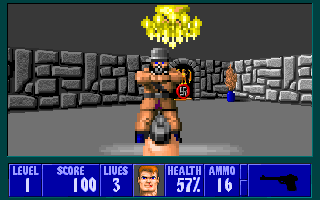
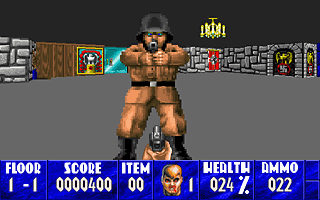
The graphics here are as basic as they can be: a level consists of a grid of squares which can be of two kinds: wall or empty space. The levels are built by filling certain blocks with different flavours of walls, and putting some enemies and goodies in other blocks. The rest is up to the game engine, which uses ray-tracing to create a 3D view of the thing. The resolution of the graphics is very low, especially in the DOS version. The low resolution makes the Nazis look merely like an accidental collection of pixels than like real persons. The Mac version (which was based on the same source code as the SNES, Jaguar and 3DO versions) has better graphics.
There is no shading at all, the walls have a different brightness according to their orientation, and the floor & ceiling are solid gray. That's it. In the DOS version, ceiling lights were accompanied by a blob of light on the floor to give an extra sense of 3D. The only revolutionary thing about the graphics was that the walls were ‘texture-mapped’ for the first time. The rendering algorithm used is a kind of simplified ray-tracer.
An advantage of the simple level structure is that it is incredibly easy to make levels for this game. You simply have to fill squares with icons and that's it. I amused myself with making levels involving very long narrow hallways stuffed with nazis, with the gatling gun and plenty of ammo ready at the start of the level. You just had to open the door and start mowing, an ideal way to relax after a hard day's work! (These levels for the Mac version can be found in the random archive.)
ROTT
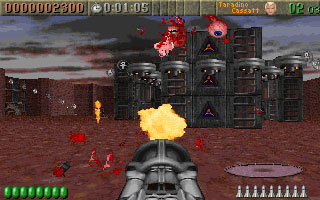
The structure of the levels in this game is basically the same as in WS 3D, with the big difference that the blocks can be of different heights (which, however, can only vary between the different levels). There can be jump pads, moving blades, iron structures which can be walked on, and floating ‘disks’ which can act like elevators or even conveyors. Another remarkable thing are the glass walls which are semi-transparent and can be destroyed. The game also has a pretty good lighting engine: lanterns cast their light on the walls and cease to when destroyed.
This was the first game with outdoor scenarios, in which landscape images scroll with the player's motions. There also is a large variance of textures with animated as well as transparant ones, which compensates for the primitive architecture. And, bullets leave holes in the walls too! As you can see from the screenshot, the game featured a lot of gore and gibs flying across the screen, including eyeballs and other body parts! The gore level was adjustable and could be locked. However, I mostly played the game with gore at maximum and the “Engine killing gibs” cheat turned on.
DOOM II
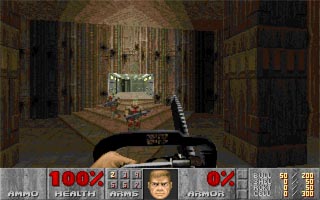
This game set the new standard for first-person 3D games of that time: the engine is a so-called “pseudo 3D engine” or “2.5D engine.” This means that the levels are built from interconnected 2D polygons which define a space with a floor & ceiling that have the shape of the polygon, with vertical walls connecting them. Said otherwise, the level is built from vertically extruded polygons. Consequently, a limitation of this is that one can never have two or more holes above each other in the same wall. In DOOM II, one cannot even have multiple floors above each other. The ceiling and floor can be at any level however, and together with the differences in the wall and floor textures' brightnesses, there is ‘depth shading’ which improves the 3D experience. Like in ROTT, outdoor scenarios with scrolling landscape images are supported. The monsters and objects are still pixelated but a bit more detailed than their Nazi ancestors. The maximum resolution of the game's display was not very detailed, at least not in the original DOS-version (the Mac version offered full 640 × 480 resolution from the start).
Duke Nukem 3D
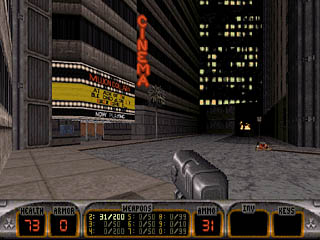
One of the first games which allowed non-horizontal floors and ceilings, although they were used sparingly. The graphics are otherwise very similar to DOOM's, except for the fact that textures of any size can be used, like billboards, and independent 3D structures can be incorporated in the pseudo-3D environment. The game also features different light colours and modes. Some structures can move or rotate, which provides interesting ingredients for certain puzzles or ways to squish the player to death. The monsters' movements are not very fluent, but that is compensated for by the exploding bodies and puddles of blood which leave trails when walked through. Like in ROTT, bullets also leave holes in the walls and even make the enemies' blood splatter against the wall. The game also features mirrors, which can cause a lot of confusion sometimes… There are liquids in which you can swim and which can change tide in a limited way, but once you go under water you are in practice teleported to a separate room, so the implementation of these liquids was rather primitive. The graphics are remarkable for the fact that they made DN3D one of the first games to successfully simulate real-world scenes.
Quake
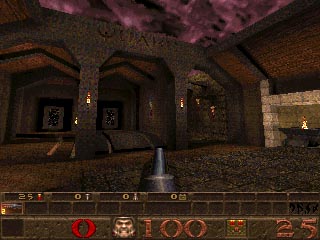
Everyone knows the great-looking graphics of this game. This was the first mainstream FPS with a full 3D engine, setting the standard for all upcoming games. Extremely realistic shading, together with distance-dependant (mipmapped) textures which decorate environments with floors and walls at every possible angle, made this the most realistic looking game of its time. Only the explosions are still sprites, and all other stuff, including monsters, are 3D models. The player's view is now fully 360°×360°, which means that you can look up and down as much as you like. The game also features liquids. When under water, you even see optical distortions, but it has to be said though, that these are a bit exaggerated… Even when you're standing still everything wobbles to and fro!
System Shock
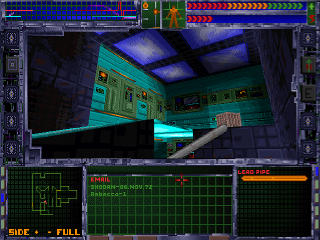
When I first started up System Shock in a DOS emulator 16 years after its release, I could hardly believe what I was seeing. Remember, this game was released in March 1994, only four months after DOOM, so one would expect that it would also feature the then ‘standard’ 2.5D engine or perhaps a slight step up from the Wolfenstein engine, but not so. The engine is a strange hybrid between a block-based engine like Wolfenstein's and a full 3D engine. The levels are still built from a grid of squares, but each cell can have a custom arbitrary height and the floors and ceilings of each ‘cell’ can be independently tilted at any angle in any direction. Actually, each cell can consist of two subparts divided by an optionally invisible wall at 45°. Although this still limits the way in which levels can be built, it allows for a very wide range of designs.
Although sprites are used for enemies and smaller objects, all larger objects like tables, chairs and machinery are real 3D objects. These objects can often be destroyed or moved. The 3D objects can also be bridges, making it possible to stack multiple corridors above each other when using the bridge as a floor/ceiling. It is possible to look all the way up and down in this game as well with correct perspective, making Quake's 360°×360° ability look a lot less spectacular now. The player can jump, crouch, crawl, lean, dodge, or do combinations of those. Objects can be pushed, picked up, and thrown. The game features dynamic lights that can pulsate or be toggled on and off. Doors and bridges can be translucent.
Next to the regular 3D environment, the player can plug into so-called ‘cyberspace’ terminals, that lead to a virtual 3D environment. This environment is drawn in wireframes, and movement is akin to flying. More about cyberspace in the game play section.
I could spare myself the effort to further describe all the features of this game's engine by saying that it does everything all the other games do and more, except liquids and 16-bit colour. Mind that all of this can run in a mere 4 MiB of RAM. If I had a hat, I would take it off and take a deep bow to the programmers of this game.
Marathon Trilogy

The first episode, Marathon, has a pseudo-3D graphics engine which is basically the same as DOOM's. Something extra however compared to DOOM, is that there is no one-to-one mapping between the player's XY coordinates and a known position in the level map. There can be as many floors above each other as one wants, but still no two holes above each other in the same wall. There can even be so-called “5-D” spaces, which means that the player can walk through two completely different corridors which share the same spatial coordinates (which is of course impossible in the real world).
The two following episodes added landscape images and well-elaborated liquids (water, sewage or lava) which can drag the player along and have tides (areas can be completely dry now, and flooded 10 seconds later). Although the implementation of these liquids must have been rather simple (the only rendering tricks are an extra moving ‘floor’ and a colour change under water), the effect is extremely realistic, also due to the excellent splashing and underwater sounds.
Complex lighting modes with interactive lights (the state of lights could be dependant on the position of switches or platforms) make the game already look a lot more interesting than DOOM. The tides of the liquids were actually linked to the state of a light, so the liquids could pulsate, rise and fall just like any light. Remarkable too are the screens between the different ‘chapters’ in the game, which really are pieces of art in episode 2 and 3, they are the work of Craig Mullins. This is also the first game of its kind which supported 16- and 24-bit colour rendering, which really looks great — if your computer is fast enough. This was unimaginable for PC games of the same period!
The first episode had quite a large ‘interface’ around the actual graphics window, making it smaller. This was not too bad because the computers at that time weren't fast enough to render the game in full 640×480 resolution anyway. You could set it to full screen, but nobody actually did because it limited the field-of-view too much and didn't provide any status information — you were dead before knowing it!
Exclusive for Marathon are the computer terminals, which can contain text and graphics. They provide information on your mission and are the medium through which the game's story (see below) evolves.
Sound & Music
Wolfenstein 3D
The sound here is as basic as the graphics: if a Nazi opens a door at the one end of the level and you are at the other end, you still hear the door open as if it was in front of you. Sound cards in PCs weren't that common at that time, so on many PCs the nazis said “bleep” and “plirrp.” Stereo sound was the privilege of owners of expensive sound cards but even then, panning is too crude to reliably locate enemies. No matter how fancy the PC sound card, the resolution of the sounds is as low as the Nazis' bitmaps (I guess 8kHz sampling rate or so), except in the Mac version (22kHz samples). The music of the Mac version is also better because it uses custom instrument samples instead of plain MIDI, yet it still becomes a bit monotonous after a while. A funny detail is that unlike in the Mac version, the ‘German’ spoken by the Nazis in the PC version was not correct because it was actually spoken by a non-native German speaker.
ROTT
This game has a pretty nice arsenal of sounds, but the quality is not really “hi-fi.” The sampling rate is quite low, about 11kHz — as a Mac gamer I'm used to better (the sampling rate of Mac-WS 3D is even higher). But it has stereo panning and multiple sound channels, so it's certainly OK. You could even have 16-bit mixing, if your sound card supported it. ROTT has a wide repertoire of pretty good MIDI background music with some memorable tracks (having a name each, like “I Choose the Stairs”), but the actual quality depends on the MIDI output device.
DOOM II
The sampling rate of the sound is again low (11 kHz) — seems like that was the standard for PC games back then — but this put aside, the quality of the sounds is quite good. The game featured stereo sound if you were handy enough to type the necessary commands (or if you had the Mac version). The music (MIDI format) is quite good, but again dependant on the output device.
Duke Nukem 3D
This game also has quite good sound, although most sounds are again at a low sample rate (that is, according to Mac standards). There is ambient sound but sparely used, and stereo panning, but not too fine-tuned. Duke's taunts when turning the aliens into forcemeat (blow it out your ass!
, hehehe, what a mess
) can add some extra fun sometimes. DN3D also has a MIDI soundtrack like most of its contemporaries, but it is nothing to write home about.
Quake
The default sampling rate here is again 11 kHz and I'm not sure whether one can change it and if that will improve the quality. Recent re-releases of Quake may have better sound, but the original sounded pretty “crunchy.” Besides that, the sounds are good with full stereo panning and ambient sound, complete with body parts splashing into the water — but there's still a lot to do to reach Marathon's level. A good idea whould be to add echoes dependant on the geometry of the room you're in — I once thought this was a feature but it appeared that the sound just skipped because the graphics engine had swallowed all the processor time!
The music is played straight from the CD, and is composed by Nine Inch Nails — quite remarkable for a game — so I suppose it will be good, but again I haven't heard it yet because I only played the demo which lacks music.
System Shock
System Shock has sound that is on par with most of the other games, with somewhat grainy sounding effects, up to eight channels (if your audio card supported it), and stereo panning. It came in two versions: first a floppy-only version, and later on a CD-ROM version. The only redeeming quality of the floppy version is that it required less memory (4 MiB) and had some exploitable glitches that were fixed in the CD-ROM version. However, if you want to play this game today, by all means play the CD-ROM version (which requires a whopping 8 MiB of RAM). It features real, high-quality voice recordings of all e-mails and data logs, substantially adding to the game's immersiveness.
System Shock also features MIDI music like most of its contemporaries. Instead of looping the same song within every level however, the music will often change subtly depending on where you are inside the level, or when you're being attacked. I have to say though that most of the music is weird and sometimes downright jarring, even when played on a good MIDI system. Most of the songs use the weirdest combinations of instruments that can be found in the standard MIDI set, and for some reason the composer really liked adding a kind of warbling sound to pretty much every song. The weirdness of the music does add to the unsettling atmosphere of a game where you're the only human left on a space station full of mutants and cyborgs, but you won't be cranking up the music for its aesthetic qualities.
Marathon Trilogy
This game (especially the two last episodes) has sound which stands above every other game mentioned here: 4-channel, 16-bit (!) samples at 22 kHz with active stereo panning, which means that when your friend comes flying across the screen after you've blasted him with your rocket launcher, you'll hear the “AAAAAARRGGGHHH” coming from your left to right, allowing you to estimate his position in space with your eyes closed (but it's such fun to watch anyway!) You can kill three BOBs (with the same weapon) without even hearing the same sample twice — and the sounds those BOBs make surely don't contribute to their survival chances! Occlusion is also implemented, which means that a sound will be more silent if there is a wall between the sound source and the player.
It is a deadly sin not to play this game with stereo headphones or hi-fi speakers. And I'm not finished yet: the quality of the sounds is consistent and no details escape the attentive listener's ear: falling bullet shells, bodies splashing into the water or lava, howling winds, dripping water or distant explosions. To keep this story short: this sound engine rules and should be an example to all upcoming games.
And now the music. Only the first episode features music, which is played through MIDI as well, and in most cases through the QuickTime Musical instruments (and these quite sucked until the release of QT 3.0). At some point while I was playing M1, my brother entered the room and he asked: what the hell is that?
He meant the weird music which accompanies certain levels, and which can be described as blues-techno-noise. Luckily the music in some other levels is a lot better and contributes to the atmosphere of the game, but those moments are rather rare. On the CD-ROM are audio tracks of these songs, played with a decent MIDI system and they sound agreeable (it would have been a good idea to allow the game to play the CD audio instead of the MIDI). I expected an improvement with the release of QuickTime 3.0, but for some reason that one plays the songs with totally different instruments, which made it only worse, so I hacked the music file and chose my own instruments (this file is available here!)
For some reason I have always found many songs on the ‘Snivilization’ and ‘In Sides’ albums from Orbital much better candidates for a Marathon soundtrack.
Marathon 2 and Infinity have no music except for the full-stereo digital space-rock intro, but instead they feature unmatched ambient and random sounds as you can read above.
Weapons
This may seem a strange criterion to use when comparing games, but at that time one of the first things one looked at when a new game was released, was which high-tech machinery was being put at one's disposition… It was a criterion as relevant as the graphics!
Wolfenstein 3D
You know what I'm gonna say: the weapons are as basic as all the rest of this game: three kinds of guns and a knife. The ‘coffee-mill’ gatling gun provides serious fun when standing in front of a group of Nazis, until you encounter the giant ‘boss’ who has two. For the rest there is nothing special about it, but not bad for the first game of this kind. The Mac/SNES port of the game also introduced a rocket launcher and flamethrower that were not in the DOS version. Those weapons actually behave more like cannons which fire large slow bullets that go straight through multiple weaker enemies before exploding, and were obviously meant for boss fights.
ROTT
Although the graphics engine is fairly basic, the weapons are not: a huge arsenal of destructive weaponry, including a genuine baseballbat! Some impressive weapons are the firebomb which is not suitable for small rooms unless you are into some very dirty suicide; a firewall which can set everything on fire that's on its path, heat-seeking missile launchers and even the ‘drunk missile’ with multiple heat-seeking projectiles, a classic bazooka and of course, different guns. It must be said that this game has an unrivaled arsenal of weapons. On top of that, some of the weapons can fire in an alternative way by keeping the fire key down. This way, you can for instance launch a wave of explosive baseballs with the “Excalibat”!
DOOM II
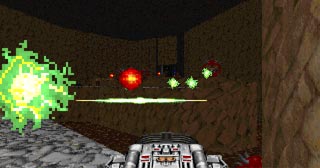
This game has all weapons one requires to kick some serious booty with: your bare fist, a chainsaw (find some meat!
), a pistol, a shotgun, a double-barreled shotgun (really a great all-around weapon), the classic ‘coffee-mill’ from WS3D, a plasma gun and last but not least: the BFG 9000. The ‘B’ stands for “Big,” the ‘G’ stands for “Gun,” and you can guess the meaning of the ‘F’ yourself. This weapon allows to wipe away everything in your line of sight. An anecdote: the only problem with the BFG, is that it appears to be designed for low resolution graphics. If I'm not mistaken, the original DOS version of DOOM had a maximum effective resolution of 320x240, but the Mac version and later improvements of DOOM for the PC could reach higher resolutions. This effectively allows to look farther than in the more pixellated version. The result is that monsters which at a large distance were reduced to a few pixels in the original version, are still discernable in e.g. the Mac version, although you can't hit them because the weapon behaves the same… Capito?
Because you can't look up or down in DOOM, the weapons attempt to fire in the correct vertical direction automatically. Of course this makes anticipating rocket shots at windows impossible.
Duke Nukem 3D
This game also has some serious weaponry comparable to ROTT, including some weird artifacts. Of course you have your gun, which is both a pistol and a submachine gun, the shotgun, a chaingun, the ultra-destructive RPG which is not recommended at close distance, and another weapon which fires explosive projectiles. The more ‘original’ weapons are the pipebomb, which can be detonated at any distance (by re-choosing the weapon each time, you can create a whole pile of pipe bombs and then detonate them all at once, nice for a spectacular suicide); the shrinker, which shrinks your enemies so that you only need to smash them with your boots; the freezer, which transforms everything into ice (again, your ‘Mighty Foot’ can be engaged for the finishing touch); and a laser beam unit which can be attached to a wall and explodes when someone passes through the beam. In the ‘Atomic edition’ (included with the Mac version), an extra weapon was added: the expander, which literally blows up your opponents!
Quake
The weapons here are not what one could call ‘inventive,’ the only original things are the grenade launcher which throws projectiles that bounce and explode after a short time, and the ‘lightning bolt’ which is effective in toasting your enemies but not quite recommended under water. For the rest there are the “boomstick” and its double-barelled counterpart, a nail gun (also available in two flavours), and a rocket launcher. The nail gun obviously fires “nine inch nails.”

The impact of these weapons can be seriously improved with the “quad damage,” which indeed quadruples your weapons' destructive force for a short period. If you encounter your friends during a net game with this stuff in their possession, your limbs are very likely to be flying around in no time.
System Shock
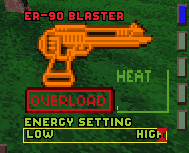
System Shock has a wide array of weapons, although when taking a closer look they are basically the same four weapons in different flavours. You start out with a simple lead pipe to whack your enemies, and find better stuff along the way. There are pistols, rifles and energy weapons. The pistols and rifles require the right ammo (with a choice of two types per weapon), that can be either recovered from dead enemies or found in ammo stashes. The energy weapons draw power from the player's ‘battery pack’ that also powers other goodies (see gameplay). The power level for most of the energy weapons can be set with a slider, so the player can optimise power usage according to whether they want to shoot a security camera or blast an armoured robot. The most powerful energy weapon fires energy balls that bounce off the walls (and cast light on them). Unfortunately this weapon can only be obtained almost at the very end of the game.
Enemies have varying weaknesses for different weapon types, and some enemies are immune to certain types of weapons (for instance, robots are obviously impervious to gas grenades).
The most powerful weapon overall is arguably the ‘laser rapier,’ a melee weapon that cuts through most enemies in less than three hits. It does require a tiny amount of electricity per hit though, so starting to slash around with depleted power is a bad idea. Next to these weapons, there are also land mines and many types of grenades, some of which have a configurable time fuse. The grenades require considerable skill though, saving before attempting to throw one proved to be pretty much mandatory, especially with low ceilings. When explosives are piled up, detonating one of them will set off the entire heap. It is not possible to carry more than seven weapons, but ammo and grenades can be collected at leisure.
Marathon Trilogy
The weapons in these three games are fairly basic, although there are some specialties. Next to the classic fists (two in episode 2 and 3), gun, machine gun and rocket launcher (the famous SPNKR which would also make an appearance in the Halo games), there are the fusion pistol and the flamethrower which can squeeze the nicest screams out of your enemies—or friends.
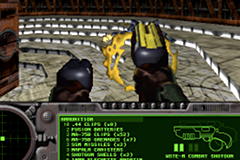 The ‘WSTE-M’ shotgun with its Terminator 2-style reloading-mechanism was added in epsiode two, and a flechette machine gun with underwater and vacuum environment firing capability was added in the last episode. The latter was most likely inspired by the experimental AAI flechette rifles from the SPIW program in the 1960s.
The ‘WSTE-M’ shotgun with its Terminator 2-style reloading-mechanism was added in epsiode two, and a flechette machine gun with underwater and vacuum environment firing capability was added in the last episode. The latter was most likely inspired by the experimental AAI flechette rifles from the SPIW program in the 1960s.
What is unique about these weapons though, is that most of them have a secondary trigger. This means that the machine gun can fire grenades as well, simultaneously with a spray of bullets, and the fusion gun can release a huge blast of energy when loaded with its secondary trigger (just make sure not to overcharge it in M2 or M∞).
To fill the hole with the weapons which don't support a second trigger, you can hold one in both hands. The only weapon which stays solo is the missile launcher — luckily, because one missile provides enough carnage on its own already. And finally there is the alien weapon, which only works until its ammo is used up — in that case you just need to kill the right kind of alien for a new one.
Gameplay and networking
Wolfenstein 3D
The gameplay here is the basis for all following games: run around in the 3D world, shoot everything that moves and find the exit. Damage taken can be healed by picking up medical kits or by eating roasted chickens mysteriously spread all over the castle floor, or even dog food. You often need to find a key in order to open some doors, but that's about the most complicated ‘puzzle-solving’ you'll encounter. Of course there are secret areas which can be reached by pushing certain walls (some people may remember hugging the walls while running and hitting the space bar like crazy). Saving can be done anytime, anywhere, like in most of these games.
A notable difference between the Mac/SNES port of WS3D compared to the DOS version, is that despite it being superior in many aspects, it lacks multiple orientations for non-player characters. Enemies always face the player in this version of the game, and it is impossible to sneak up to someone by remaining outside their field-of-view.
No network options whatsoever…
ROTT
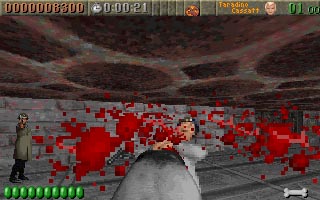
Basically, the same objective, but there are some extras which make it more interesting: your opponents have their own kinds of weapons, and they can even steal some of your weapons and use them against you! The game also features some ‘powerups,’ of which the most funny one is undoubtedly “Dog mode,” which turns you into a killer dog — sometimes this is a necessity to get underneath some very low passageways. You also have to turn switches or move pillars and walls to be able to complete most levels. Looking up and down is possible, but only in a limited range because the view only scrolls, hence there is no perspective correction. The game is roughly divided into ‘episodes,’ with a ‘boss’ to defeat at the end of each episode.
Next to the powerups, there are also special items in each level which you can collect. There are various items with different values, but once you have 100 points you get an extra life. You can also try to shoot all these items instead, giving you the “Bull in china shop” bonus at the end of the level! There are other bonuses too, e.g. for finding all secrets or killing all enemies.
The game has networking (called “Comm-bat”), so you can blow away your friends over a serial or modem connection. You can choose between different types of network games, including a few original ones like ‘tag,’ or collecting as many floating triangles as possible. An impressive feature is that you can even send live sound messages to other players! I never played this in network, but I guess it must have been serious fun with all those weapons.
DOOM II
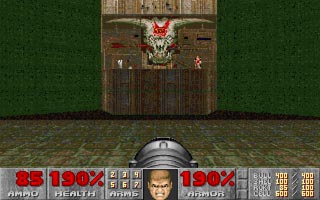
Single player mode is similar to ROTT but you can't look up and down (as explained in the weapons paragraph). There are no real bosses, only an army of monsters which gets bolder and badder with each level (about 30 levels in total). The only real boss is in the last level, where you need to pump a rocket in the demon's brain which spawns all those monsters. Next to the classical health status, you also have armor, and you take less damage when your armor status is high. The levels are also roughly divided into a few ‘chapters,’ with a short intermezzo text in between.
This game, as well as the following ones, ditched the concept of keeping a score for each enemy you kill and so on. The objective has moved from getting the highest score to ‘simply’ finishing the game. Nevertheless, at the end of each level you still get an overview of how many secrets you have found and how many enemies you have wasted.
DOOM also has network gaming, similar to ROTT but with fewer options. You can try to finish the levels together with your friends, but the most popular network game was probably “every man for himself”: just run around and kill as much as you can (which would soon be referred to as “fragging”).
Duke Nukem 3D
The same basis plus the ability to jump, but with quite a few interesting extras. This game had some really innovative features for its time. It took quite a while before they would become commonplace in games.
The game consists of separate episodes, and new ones can be added. Most levels contain some kind of interactive machinery, like conveyor belts with cranes which pick up anything which comes under them (including the player). Sometimes you can only continue a level by having yourself shrinked, either by a machine or by shooting your shrinker against a mirror. You can also “interact” with the environment in very funny ways, like playing billiards or just going to the toilet (can increase your health!) and kicking the toilet bowl to shards afterwards. Amidst inventory items is a jet pack, which allows to fly for a limited time. This is also the first game in which one can take damage by falling or even fall to death. The player can be crushed by cogwheels or other moving structures. In a certain level, there's even a subway with a moving train! The game also has teleporters, which teleport anything that enters them (it is even possible to make a rocket loop between the teleporters in a certain level!) Another nice feature are the security cameras, which work exactly like the real thing, the cameras can even be shot. Looking up and down is also possible within a quite large range, but this again only scrolls the view, resulting in severe distortions when looking too far up or down.
The objective of each level is to find a large button which apparently serves to nuke the entire environment, which I have always found a strange objective for a game… :-)
DN3D has networking similar to DOOM. Like in ROTT, the arsenal of unique weapons is a guarantee for serious fun.
Quake
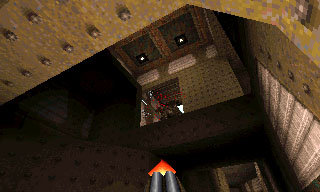
The supplements to the basic ingredients are the ability to jump and to look all the way up and down while maintaining correct perspective, thanks to the fully-3D engine. The ‘action’ key is obliterated: pushing a switch is as simple as walking against it or shooting it. You also take damage by falling, although you always lose just 5% health regardless of how deep you fall. (Level designers will generally place a so-called “HURT” trigger at the bottom of deep chasms which will instantly inflict lethal damage to simulate a deadly fall.) As in DN3D, the player can be crushed by moving structures (only translation is possible however, no rotation like in DN3D). There are also teleporters and ‘traps’ like nails shooting from the walls or floors, as well as air ducts or force fields that can push the player in a certain direction.
The gameplay is otherwise not too different from the other games discussed here: get through the levels and kill as much as you can — while you're busy anyway. If there are puzzles in the game, they're mostly as simple as push-the-button-and-the-door-opens. Usually a message on the screen will even tell you what to do to open the door anyway. Rather dissapointing compared to those great graphics, but I guess programming these took too much time to take care of something else. The game is divided into four ‘worlds,’ and in each world you must find one rune. Once you have all runes, you can finally defeat the big boss, which requires performing a specific trick commonly used in network games.
Quake extended the networking abilities of DOOM: this time one could not only play over a LAN or modem, but also over a TCP internet connection. This of course made network gaming incredibly popular. In the sequels to Quake, the emphasis was put on online gaming and the remainders of a plot even disappeared completely in Quake III.
One special way to ‘frag’ an opponent in Quake is to enter a teleporter at the moment when the opponent is situated at the destination location. This would disintegrate the opponent and is called ‘telefragging.’ Although this concept already existed in DOOM, Quake made it more commonplace.
System Shock
System Shock is pretty unique in its design. Aside from the total absence of network features, it was in fact years ahead of all the other games, both in its level design and gameplay. System Shock introduced many elements that gamers only started to take for granted well into the 21st century. While all other games reviewed here feature a linear progression through their levels, System Shock plays as one huge level divided in sections, and allows to return to levels you've previously been to. Everything will still be the same way you left it, except for possibly re-spawning monsters. Remember, this game could run in only 4 MiB of RAM! System Shock is set in a space station with multiple floors, connected by elevators (complete with elevator muzak). It is often necessary to return to a previous level to complete a task, to unlock something in another level, or to heal yourself at one of the scarce surgery machines.
While System Shock does have a classic save & load system, it also features resurrection chambers in most of the levels. Once the player has toggled these from ‘cyborg conversion mode’ to healing mode, they can ‘safely’ die anywhere on that level, and will be resurrected inside the chamber. This is a similar mechanism as used in the sequel System Shock 2, and the much more recent BioShock.
The game has a classic ‘health’ bar, as well as an ‘energy’ meter. Obviously, when the health reaches zero you die, but if the energy bar reaches zero you won't necessarily die, at least not directly. As indicated before, energy weapons drain power, but ‘plug-ins’ do so as well. The player is equipped with a neural implant that can interface with all kinds of gizmos that can be collected across the game. Each of those gizmos, for instance a projectile shield, night vision or hazmat suit, can be toggled at will but they all have a certain power drain. The player can collect more advanced versions of the implants as the game progresses, giving it a RPG aspect. Energy can be replenished through recharge stations, or through batteries in the player's inventory.

The player's inventory does not only hold weapons and batteries, but also other items as well as data logs. Like with weapons, room for miscellaneous objects is also limited. About every small object can be picked up and carried, but not all objects are useful (you can collect severed limbs and heads all over the station if you wish, but they won't be of much help). Among the most useful objects are ‘dermal patches’ that have various effects. There are healing patches, sight enhancing patches, speed-boosting patches, reflex patches that will slow down the entire game, berserk patches that increase melee fighting strength, and so on. Most of these patches have an after-effect that is contrary to their intended effect, for instance the sight-enhancing patch will first increase brightness in dark areas, but will make everything look darker for a short while when it has stopped working. In the (in)famous IT-HE walkthrough, the patches are likened to drugs, which is kind of accurate given the way they work. Luckily there are also ‘detox’ patches which will instantly neutralise the effects (good and bad) of any currently active patch.
Each level features security cameras and computer nodes. The number of active cameras and nodes determines ‘level security’ and the higher the security, the more control SHODAN has over the level (see plot). Lowering level security by destroying the cameras and nodes is necessary to open certain doors. Just like in Duke Nukem 3D, the player can use cameras to remotely look at a different part of the level.

Another unique feature of SS is ‘cyberspace,’ which is kind of a game-inside-the-game. The player can connect to cyberspace terminals, which lead to a virtual world rendered with wireframe graphics. Inside this world, software and data can be collected, and switches can be toggled that control doors in the real world. Movement is like flying with a constant forward thrust that can be adjusted within a limited range. There are enemies as well, which can be defeated after collecting weapon software. The concluding ‘boss fight’ also happens in cyberspace.
Although the emphasis on the cyberspace concept really dates System Shock as a mid-nineties game, it does provide a nice change of pace because it is very different from the rest of the gameplay.
As you should be figuring out by now, System Shock is a pretty complex game, therefore it has somewhat of a steep learning curve. Still, the makers did a good job to give you enough time to get acquainted with the entire set of features until you really need them in the final levels. The enemies get gradually tougher and eventually you will be required to start using your cyber implants and the dermal patches, and improve your weapon skills. The enemies have pretty quick reflexes and also a good aim, so just running around and shooting wildly won't get you far. Both the steep learning curve and the complex game engine's high hardware requirements might be two major reasons why System Shock didn't really catch on. It was just a bit too far ahead of its time. DOOM and DOOM II, released only shortly before and after System Shock, were in comparison pathetically simple in every aspect, but that also gave them a much smoother framerate and a less steep learning curve.
Noteworthy is that as far as I know, System Shock has no cheat codes.
Marathon Trilogy
All Marathon games are divided into ‘chapters,’ which consist of several levels (about 25 in total per game). Each level has a certain ‘mission,’ which can be: kill all aliens, save at least 50% of the ‘BoBs’ (very hard :-) ), get a chip card, throw the right switches and insert the right key cards… Or just explore a level and get out, which is not always as simple as it may seem: some levels involve real puzzles which require brain-work rarely found in games like these. Especially the first and last episode have some levels which can take a day of continuous play to get through — and that's not only because they're stuffed with aliens.
Next to the ‘shield’ (health), you also have an oxygen supply. This is steadily drained in vacuum levels or under water, so you need to recharge both your shield and oxygen, which can be done by picking up canisters or using special rechargers in the wall. Looking up and down is also possible here, but again only in a limited range because it is implemented by scrolling the view.
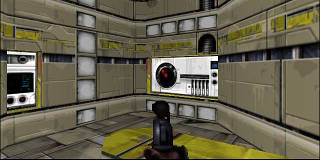
Marathon has its own concept of saving games: saving is only possible at “save terminals” in the walls. This means that the designers of the levels decide where you can save and where not. This has produced some very annoying and ill-designed third party maps, but the Bungie maps were always provided with enough terminals. There are also other terminals, but more on these in the “story” part…
A most remarkable feature of this game, and other Bungie games as well, is that like System Shock, they do not have a ‘cheat’ feature. No cheat codes whatsoever! The only way of “cheating” is to save, then tune down the difficulty level and re-opening the game. This works, because although the difficulty level is saved, the preferences are used for the first reload of a game.
The network play features of this game are similar to the other games, especially ROTT (something tells me this is not a coincidence, these games were also released on the very same day, by the way…) You can use any LAN to play with up to eight players. From Marathon 2 on, some innovative network games were introduced, like “Kill the Man With the Ball” (which is actually a skull, by the way), “Tag,” “King of the Hill,” and so on. When finishing, you get a nice “Post Carnage Report” with all kinds of statistics (including Total Carnage). And even nicer: every game you play (also in solo mode) is recorded, so you can play it back at any time! So, this game certainly has nice networking features, unfortunately there was no support for Internet connections yet (this was added in the AlephOne port).
Real-time audio over the network (like in ROTT) was also foreseen, but strangely enough worked worse on the newer PowerMacs than on the older models…
Plot
Each of these games is built around a plot, or better: a plot is wrapped around most of these games — with two big exceptions.
Wolfenstein 3D
The plot is, again, as basic as the graphics and sound: you are a prisoner of the Nazis and you need to escape. Duh. In the full version there are more missions which can each be described in a single sentence, and culminate in having to kill Hitler himself (let's see that again!
) So: somewhat ‘educative’ (?) but not what one can call ‘elaborate.’
ROTT
The plot of this game is not much more complicated: you are part of a kind of A-Team which needs to clean up some dirty organization which plans to conquer the world or something like that. You can play different characters, but this only influences some parameters like speed and damage resistance, and the taunt you say when blowing up an enemy in ‘ludicrous gibs’ mode.
DOOM II
In this game you are a space marine on Mars who is sent to investigate a distress signal from the moon of Deimos, where a large corporation has been performing experiments in teleportation. You wait in reserve as your friends are slaughtered. Now it's your turn.
Well, the simpler the more people will understand it, can be the motto. Some levels have puzzles which require a bit of brain work to solve, which makes them somewhat more interesting than just-blow-it-all-away (which is fun too, though!)
Duke Nukem 3D
Aliens seem to provide a lot of inspiration with makers of 3D games, because this game deals with them too: this time Earth itself is attacked by aliens who have transformed the police squad into pigs and want nothing more than absolute dominion over the planet. Your mission: kick their butts. Simple, but effective. Most levels appear to have some kind of story behind them, but it is mostly up to you to guess. Some information (or rather, motivation to shoot more aliens) is given in short movies or intermezzo screens.
Quake
While in DOOM there was still a pretty straightforward story, this time the game seems to be situated in a time- and space-less universe with strange creatures of all kinds and a mix of modern and antique technology — but finding out what it is good for is up to the inventive players. The whole bathes in a ‘hell-ish’ atmosphere, but if there would be any story, it could probably be told in ten lines of text. My bet is that the game manual contains those ten lines of text, but let's be honest: who ever reads game manuals? There is no in-game introduction: the player is dumped straight into the now iconic difficulty selection lobby. There are short text screens after finishing each ‘episode,’ but it is all pretty vague and generic and basically just tells what one needs to do to finish the game.
There are some nods to the film ‘Army of Darkness,’ but only in a few game elements. After Quake's success, it seems that they did construct a more substantial fictional universe. This was used as a basis for the sequels, even though it would take a while before any Quake-related game had the mechanisms required to properly tell a story in-game.
System Shock
Finally it gets interesting. I must say, until I played System Shock sixteen years after its release, I believed Marathon was the first FPS to feature a real involving story. I was wrong. System Shock also features a pretty extensive story cleverly embedded into the game play.
When starting a new game, a cut-scene explains you are a hacker who got caught for cyber crimes. Instead of being jailed, Edward Diego, a corrupt official from the TriOptimum corporation you broke into, hires you to ‘tweak’ an Artificial Intelligence called SHODAN on board of the Citadel space mining station. As a favour you get a neural implant in return, but this requires you to stay in stasis for six months. When you wake up on board the station, it becomes clear that thanks to the extra liberties you gave to SHODAN, a lot of not quite good things have happened in those six months. To be more specific, SHODAN has taken complete control of the space station and has used its human inhabitants for genetic experiments and to create an army of cyborgs and robots. Of course SHODAN is not satisfied with that and plans to bring death and destruction to earth. You're the only one who can stop this from happening. Although the game is set in space, it does not feature aliens for a change.
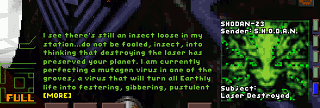
System Shock deserves credit for being the first shooter that does much more than throwing a vague and weak story at you in an intro screen or intermissions, and then letting you guess for the whole rest of the game why you're running and blasting. After the introduction cut-scene, the story further unfolds inside the game itself by means of e-mails and data logs that are scattered across the levels. Reading logs does not interrupt the game, you could be shooting at enemies while reading (which you probably don't want to do, because the enemies are pretty tough). In the CD-ROM version you don't even need to read the logs because they are accompanied by spoken text (although weirdly enough the audio in most cases only loosely matches the written text). You could just play System Shock while ignoring all of those and play it like a simple shooter, but you would miss out on so much. The mails and logs gradually teach you what happened on the station in those six months, and what is required to stop SHODAN from trying to attack earth itself. Granted, the story is not of the utmost complexity: it only explains what needs to be done to finish the game and there is hardly any character development (you do learn things about some characters, but they're all dead), but it is a whole lot better than “hell has come to earth, time to kick demon butt.”
Marathon Trilogy

Here it gets really interesting. The plot of this game starts similar to DOOM's: in a nearby future, the colony spaceship Marathon is being attacked by — again — aliens, and you, the security officer who had nothing to do until now, needs to make 'em suck vacuum. Until here, a classical cliché-matic cheesyplot as usual. Luckily things change radically when advancing through the first levels as you discover that Durandal, one of the ship's Artificial Intelligences, appears to have gone slightly nuts (well, doesn't this sound familiar). This, as well as some other subtle correspondences, makes me believe that System Shock was an inspiration to Bungie, but luckily Marathon doesn't blatantly copy it. Instead, it takes the story element to a whole new level. Durandal starts to play dirty games with you, and seems to show more sympathy for the aliens than for mankind. Yet, Durandal proves not to be just a nutter who wants to conquer earth or something, but has much more exalted plans. As you proceed to episode 2, things become more complicated when another AI shows up which seems to have become “rampant” as well — maybe even earlier than the first one. Of course they start to fight each other, and you're sandwiched in between. In the last episode the whole story becomes so complicated that you don't even know anymore who you should consider ‘friend’ or enemy, and where a wrong move can send you back to a previous part of the story. The story of the entire trilogy doesn't span a few hours or even days, but probably years, and many things evolve over time.
If you haven't played the game, you may wonder how it is possible to seamlessly combine 3D game action with such an elaborate story. The answer is the terminals: they are the means of communication between you and the AIs or other game characters. They can also be just informative terminals featuring history (which gives the story even more depth) or a random piece of information, which can sometimes just be something funny. Similarly to reading e-mails or logs in System Shock, logging into a terminal does not distract from the game: you walk up to it and hit the ‘action’ key. You still hear the environmental sounds while reading the terminal, your motion sensor still tracks enemies and you can even be attacked. So the terminals are part of the environment you're walking around in, and not just a separate window with scrolling text or isolated intermezzo screens that freeze the game. This really ‘weaves’ the story into the game without disturbing gameplay. It is not being told, it is played… by you. The story is divided into chapters, as described in the gameplay section, but this is more like a cosmetical enhancement because the story runs mostly continously through the entire game.
Feature comparison table
To summarise how all these games compare to each other, here is a comparison in table format for most distinctive features, both important and small ones. An explanation of the non-trivial feature names can be found below.
| Feature | WS3D | ROTT | DOOM | DN3D | Quake | SS | M1 | M2&∞ |
|---|---|---|---|---|---|---|---|---|
| 16+Bit | Y | Y | ||||||
| Polygons | Y | Y | Y | Y | Y | |||
| Storeys | Y | Y | Y | Y | Y | Y | ||
| VariHeight | Y | Y | Y | Y | Y | Y | ||
| Slanted | Y | Y | Y | |||||
| 3DModels | Y | Y | Y | |||||
| Movables | Y | |||||||
| DynLights | Y | Y | Y | Y | Y | Y | ||
| Translucency | Y | Y | ||||||
| LookUpDown | Y | Y | Y | Y | Y | Y | ||
| +Perspective | Y | Y | ||||||
| Jumping | Y | Y | Y | |||||
| Crouching | Y | Y | ||||||
| Cameras | Y | Y | ||||||
| Liquids | Y | Y | Y | |||||
| SecTrigger | Y | Y | Y | |||||
| Grenades | Y | Y | Y | |||||
| Network | Y | Y | Y | Y | Y | Y | ||
| Plot | Y | Y | Y |
- 16+Bit: the game can render in 16- or 24-bit colour.
- Polygons: the levels are constructed from extruded 2D polygons (pseudo-3D engine), or in the single case of Quake, are full 3D.
- Storeys: the player can walk at different ‘floors’ that are above each other.
- VariHeight: the floors and ceilings can have varying heights within the same level.
- Slanted: slanted surfaces (i.e. that are neither horizontal nor vertical) are possible.
- 3DModels: real 3D models can be used inside the game world.
- Movables: objects can be moved in any direction by pushing, throwing or shooting at them.
- DynLights: there is significant use of lights that change state based on player-triggered events. This includes projectiles casting light on nearby walls.
- Translucency: structural level elements can be truly translucent, i.e. not rendered through dithering but through mixing colours.
- +Perspective: looking up & down doesn't just scroll the view, the perspective stays correct.
- Cameras: textures can show a real-time view of different locations in the level.
- Liquids: the player can be submerged in water or other liquids.
- SecTrigger: weapons can have a secondary trigger or two weapons can be fired simultaneously.
- Grenades: there are projectiles that can be thrown, or bounced off walls before exploding.
- Plot: the game has an elaborate plot told through in-game elements.
Conclusion
Next to being a game of good quality in most aspects, it's mostly the story which makes the Marathon trilogy stand far above most of the other games from the same time period, with only System Shock being a close contender. The other games have an absolute lack of involvement beyond running and shooting. Those games have no developing characters or unexpected twists, and in their last levels you're still shooting enemies for the same reasons as in the first levels. While System Shock is technically superior in many aspects to all its contemporaries including the Marathon games, its story is much simpler and straightforward but still beats the remainder of the games hands-down.
Marathon's story starts with the inevitable clichés, but quickly evolves to a depth not found in any other FPS game of its era. The ‘extras’ of the game engine, namely the terminals (in the first place), the missions, the liquids and the controllable lights and sounds are being put to good use to shape the storyline and give it depth. The story is more than just what happens aboard the spaceship and the alien planets, you also get to know what happened before the alien invasion and even the history of the spaceship Marathon. You also find out that the AIs have their emotions too, and you might even feel emotions yourself when being forced to destroy the core of the AI you have been talking to during the previous levels… This is what makes the game really interesting: it not only has a story, you're part of it. The story feeds your fantasy so you see more than just the texture-mapped polygons displayed on your screen. The rooms and spaces get a meaning or even a history, next to just being a place where you can spread the bowels of your enemies all over the floor (which, of course, is fun too). No need to say that this makes the game much more exciting. You actually get good reasons to blow 'em all away! It would probably be possible to create a good movie or television series based on Marathon's story.
For a long time Marathon and System Shock have been nearly the only FPS games which really had a story. It would take until Half-life (1998) for another FPS game to appear that was built from the ground up around an interesting and elaborate storyline told through in-game elements, making the player ‘feel’ part of it. After this, game developers seemed to have learned their lesson and started to put more work in this aspect of their games. Nowadays, one can't release a game without at least an attempt to give it an interesting storyline, unless the specific goal is to provide a kick-ass multiplayer experience such as in Unreal Tournament 2004.
For those people not interested in stories, Marathon had practically everything the other games of the same period had, plus some original forms of network-play. Of course people have found their own ways of playing the game, for instance as fast as possible, without using any weapons, or by only using one's fists… A kind of ‘cult’ has evolved from this, with its own vocabulary with words like Vidmasters, Spazeroids, grenade-hopping, hang time, …
It is also noteworthy of course that at that time, Marathon was one of the only first person action shooters available for the Macintosh platform. This of course made the game especially popular amidst Mac users. But even when DOOM and most other 3D games became available for the Mac, the game still remained most people's favourite… And with the game engine having become open source, users of all platforms will be able to enjoy the game and create their own worlds with an own story in it!
It would take several years until other combinations of plain 3D action with a deep storyline would start to show up, e.g. Half-Life, System Shock 2, Deus Ex, Max Payne, … With Marathon's successors like Myth and Halo, Bungie has tried to stick to the tradition of weaving a story into a game. (People who have played both Halo and Marathon will have noticed that Halo borrows a lot from Marathon.) But it cannot be denied that there is something about the Marathon story which is missing in the newer games. Because at the time Marathon was made, Bungie was still a small company basically run by recently graduated students, the game has a real character of its own. It seems to strike a great balance between both naivety and professionalism. The games Bungie makes nowadays as a major commercial game developer are the product of massive teams of people who both need to find a balance between all their individual ideas, and make sure that the game will please as many consumers as possible. The result may still be a great game at the moment you are playing it, but it's impossible to give such a “mass production” a ‘character’ that can stand the test of time like the one of a small-scale production like Marathon. When you're with only five people, you can easily write a story in which the opinions of each of the five are represented. When you're with 50 people however, you can only take some “average” of opinions, and averages are not quite as exciting as extremes. They are like flat hills compared to sharp mountains.
With these ‘philosophical’ thoughts I'll conclude this text. If you now feel like playing the game, head over to the AlephOne open source project, and read the info there! And don't forget to come back to try out some of my custom maps.
Update 04/2003: The source code for ROTT has also been released to the public. If you search on the net, you'll find some ports of the game which are playable on most modern operating systems (including Mac OS X and Linux). The same goes for Duke Nukem 3D and Quake! Have fun!
Update 01/2005: You can now simply legally download the entire Marathon trilogy from Bungie! These are the contents of the Trilogy CD set. In other words, it are the Mac OS 9 versions only, but you can unstuff the archives too on OS X/Windows/Linux with the right tools, and plug the game files into Aleph One.
See ya starside…
If you have any comments, corrections or missing info about the abilities of the games mentioned here, feel free to mail them to me.